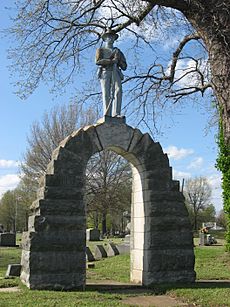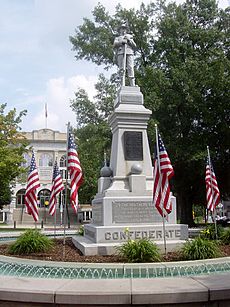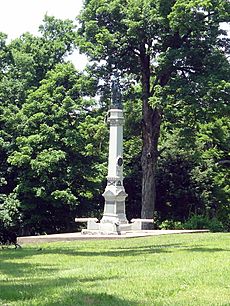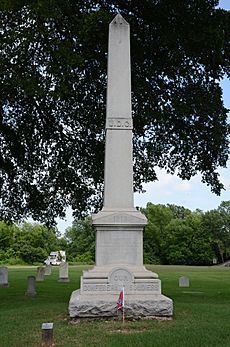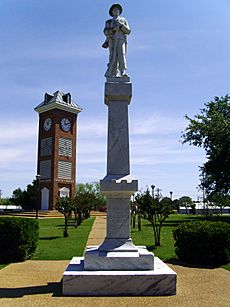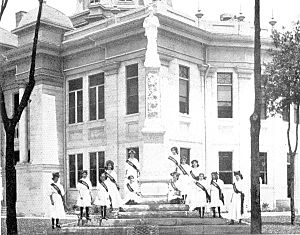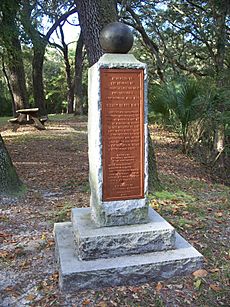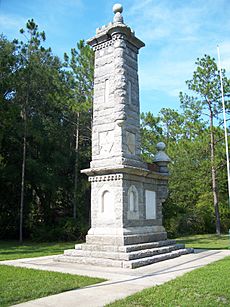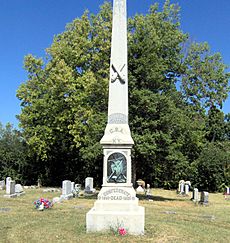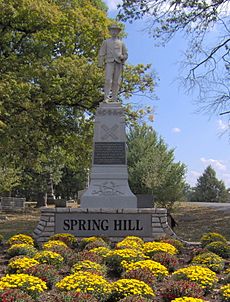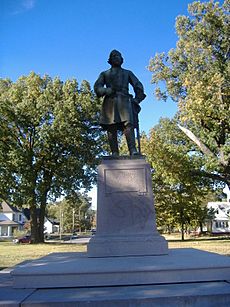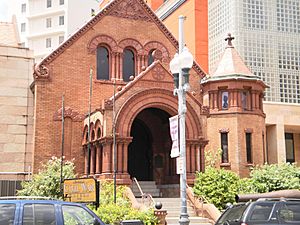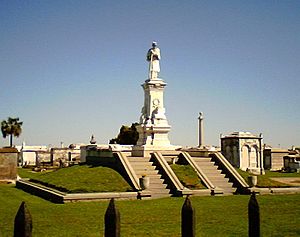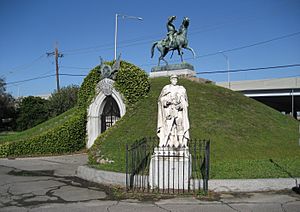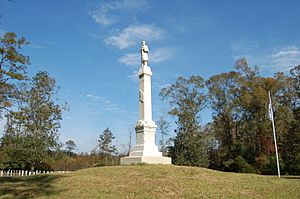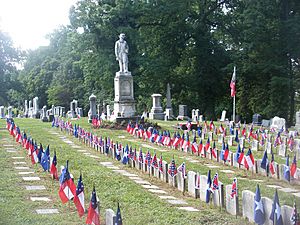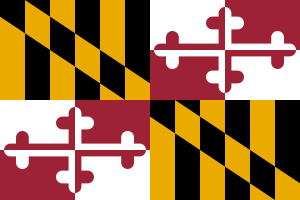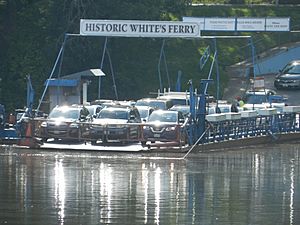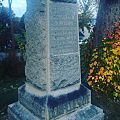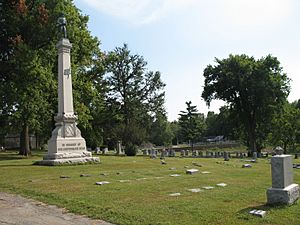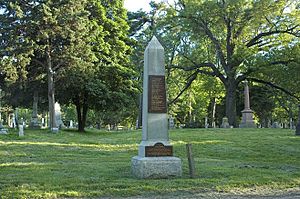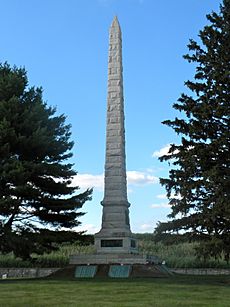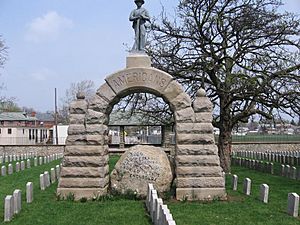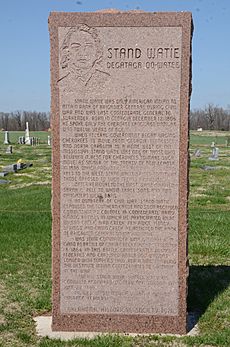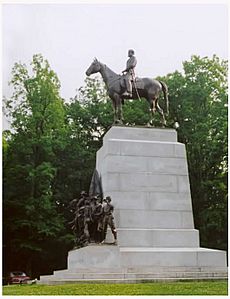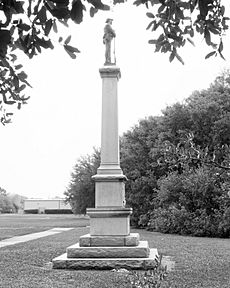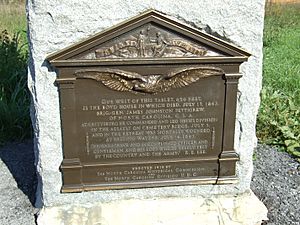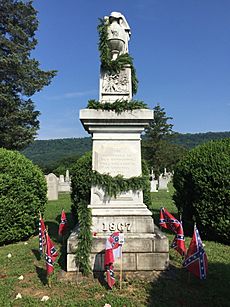List of Confederate monuments and memorials facts for kids
Confederate monuments, memorials, and symbols are public displays in the United States. They honor the Confederate States of America (CSA), its leaders, or soldiers from the American Civil War. These symbols have caused a lot of debate and continue to do so. Many of them have been removed or are in the process of being removed.
These symbols are part of how the American Civil War is remembered. They include statues, flags, holidays like Memorial Day, and names for schools, roads, parks, and other public places. A report in 2018 found that over $40 million has been spent on these monuments and related groups in the last ten years.
This list does not include people linked to the start of the Civil War or white supremacy who were not part of the Confederacy. It also doesn't include white supremacists from after the Civil War.
Monuments and memorials are listed by state and then by city. States not listed do not have known items for this list.
History of Confederate Monuments
Why Were Monuments Built?
Many memorials were put up in public places like courthouses. They were paid for by governments or by private groups and people.
Smithsonian Magazine says that American taxpayers still spend a lot of money on these tributes today. The report also found that these monuments were built to promote the Lost Cause idea. This idea was a way to remember the Confederacy that supported white supremacy. African American leaders often protested these memorials because of what they stood for.
A few memorials were made during the war, mostly names for ships and places. After the war, General Robert E. Lee said he didn't want any monuments. He felt they would "keep open the sores of war." However, monuments continued to be built soon after the Civil War. Many more were built after 1890, especially at Civil War battlefields.
The Jim Crow Era and Monuments
Building Confederate monuments was often part of a larger effort to support Jim Crow laws in the South. These laws enforced racial segregation. The American Historical Association (AHA) says that monuments built in the early 1900s were meant to hide the violence used to end Reconstruction. They also aimed to scare African Americans politically and keep them out of public life.
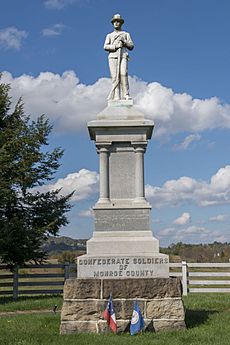
Another wave of monument building happened during the Civil Rights Movement. The AHA says these symbols of white supremacy are still used for similar reasons. Smithsonian Magazine noted that these memorials were funded by Jim Crow governments. They honored a society that relied on slavery and showed power over African Americans.
Historian Jane Dailey from the University of Chicago says the monuments were meant to promote a "white supremacist future." Karen L. Cox, a historian from the University of North Carolina at Charlotte, wrote that the monuments are "a legacy of the brutally racist Jim Crow era." She added that "the whole point of Confederate monuments is to celebrate white supremacy." These monuments were built without the agreement of Southern African Americans. They remembered the Civil War very differently and did not want to honor those who fought to keep them enslaved.
Historian James I. Robertson Jr. from Virginia Tech University said in 2018 that the monuments were not a "Jim Crow signal of defiance." He called the removal of monuments an "age of idiocy." Katrina Dunn Johnson, a museum curator, said that many families could not find their soldiers' remains. She believes this loss helps explain why Southerners wanted to build memorials.
Many Confederate monuments were put up by groups like the Ladies' Memorial Associations, United Daughters of the Confederacy (UDC), and Sons of Confederate Veterans (SCV). Many are listed on the National Register of Historic Places. Art historians Cynthia Mills and Pamela Simpson said that most Confederate monuments were "commissioned by white women." They hoped to keep a positive view of life before the war.
In the late 1800s, new technology made monuments cheaper to build. Companies often sold similar monuments to both the North and South. Another wave of building happened during the Civil Rights Movement and the American Civil War Centennial. At least 32 Confederate monuments were dedicated between 2000 and 2017.
Studying the Monuments
Studies of these monuments began in the 1980s. John J. Winberry found that most monuments were built between 1889 and 1929. Over half of the courthouse monuments were built between 1902 and 1912. He found four main locations for monuments: battlefields, cemeteries, county courthouses, and state capitols.
Winberry described four types of monuments:
- Type 1: A Confederate soldier on a column, often at rest or gazing into the distance. This was about half of the monuments, especially popular at courthouses.
- Type 2: A Confederate soldier on a column with a rifle ready, or carrying a flag or bugle.
- Type 3: An obelisk, often with drapes or cannonballs. This was 28% of monuments, common in cemeteries.
- Type 4: A mix of other types, like arches or plaques.
Over a third of courthouse monuments honored Confederate soldiers who died. The first courthouse monument was in Bolivar, Tennessee, in 1867. Winberry noted that monuments spread from Virginia to North Carolina, and also across Georgia, South Carolina, and northern Florida. Groups like the United Confederate Veterans helped this spread.
Winberry listed four reasons for building monuments at courthouses instead of just cemeteries:
- To remember the Confederate dead and honor veterans.
- To celebrate the rebuilding of the South after the war.
- To romanticize the Lost Cause.
- To unite the white population against African Americans in the South.
He concluded that no single reason fully explains the monuments. They are symbols that can be hard to understand.
The Monument Movement
The Monument Movement was a national effort in the late 1800s and early 1900s. Both Union and Confederate monuments were built as community memorials. Communities came together during the war to send their men and boys to fight. Then, they came together again to honor these soldiers. Citizens raised money through donations, monument associations, and taxes. Groups like the GAR (Grand Army of the Republic), United Daughters of the Confederacy, and United Confederate Veterans led these fundraising efforts.
Early monuments included a Confederate one for Colonel Francis S. Bartow, built after First Manassas but later destroyed. Early Union monuments were built in Kentucky in 1862 and Massachusetts in 1865. By 1867, the first post-war Confederate monuments were put up in West Virginia and South Carolina.
The Monument Movement also saw monuments for the Revolutionary War, especially around its 100th anniversary from 1876 to 1883.
Monument Removal
As of April 2017, at least 60 Confederate symbols had been removed or renamed since 2015. This information comes from the Southern Poverty Law Center (SPLC). However, laws in some Southern states make it hard or impossible to remove statues or rename places.
A 2017 poll found that 54% of adults believed monuments should stay in public spaces. 27% thought they should be removed, and 19% were unsure. White people and Republicans generally wanted to keep them, while Black people and Democrats were more likely to support removal. Support for removal grew during the George Floyd protests in 2020, with 52% in favor.
| Time period | Number of removals |
|---|---|
| 1865-2009 | 2 |
| 2009-2014 | 3 |
| 2015 (after Charleston church shooting) | 4 |
| 2016 | 4 |
| 2017 (year of the Charlottesville car attack) | 36 |
| 2018 | 4 |
| 2019 | 4 |
| May 25-July 2, 2020 (during George Floyd protests) | 30 |
Where Are Confederate Monuments Located?
Confederate monuments are mostly found in the southern United States. Their locations generally follow the old borders of the Confederacy. Out of more than 1503 public monuments, over 718 are statues. Nearly 300 statues are in Georgia, Virginia, or North Carolina. The northern states and western states have few or no Confederate memorials.
National Confederate Symbols
United States Capitol
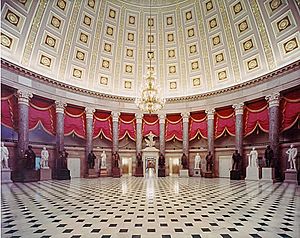
The National Statuary Hall Collection in the United States Capitol has statues of two important citizens from each state. Some Confederate figures are among them, often in Confederate Army uniforms.
- Zebulon Baird Vance (North Carolina, 1916)
- Uriah M. Rose (Arkansas, 1917)
- Edmund Kirby Smith (Florida, 1922). Florida decided to replace this statue with one of African-American educator Mary McLeod Bethune.
- Joseph Wheeler (Alabama, 1925)
- Alexander Hamilton Stephens (Georgia, 1927)
- Wade Hampton III (South Carolina, 1929)
- Jefferson Davis (Mississippi, 1931)
- James Zachariah George (Mississippi, 1931)
- Jabez Lamar Monroe Curry (Alabama, 1908) was replaced by a statue of Helen Keller in 2009.
The Peace Monument in Washington, D.C., built in 1877–1878, honors naval deaths during the Civil War.
Arlington National Cemetery
Arlington House, Robert E. Lee's home during the Civil War, is now a memorial. It became part of Arlington National Cemetery to prevent Lee from returning. The National Park Service says it honors Lee for his role in promoting peace after the war. It also serves as a place to study difficult parts of American history, including slavery.
The Confederate Memorial at Arlington National Cemetery was built by the United Daughters of the Confederacy. It was approved in 1906 and unveiled by President Wilson in 1914.
Coins and Stamps
The U.S. Mint featured Robert E. Lee and Stonewall Jackson on the 1925 Commemorative silver U.S. half dollar. This coin helped raise money for the Stone Mountain monument. Robert E. Lee has also appeared on at least five U.S. postage stamps.
U.S. Military Names
Military Bases
There are 10 major U.S. military bases named after Confederate military leaders. All are in former Confederate States. In 2015, the Pentagon said it would not rename these facilities.
- Fort Lee, Virginia (1917) named for CSA Gen. Robert E. Lee.
- Camp Beauregard, Louisiana (1917) named for CSA Gen. Pierre Gustave Toutant Beauregard.
- Fort Benning, Alabama/Georgia border (1917) named for CSA Brig. Gen. Henry L. Benning.
- Fort Gordon, Georgia (1917) named for CSA Maj. Gen. John Brown Gordon.
- Fort Bragg, North Carolina (1918) named for CSA Gen. Braxton Bragg. It is the largest military base in the world by population.
- Fort Polk, Louisiana (1941) named for CSA Gen. Leonidas Polk.
- Fort A.P. Hill, Virginia (1941) named for CSA Lt. Gen. A. P. Hill.
- Fort Pickett, Virginia (1942) named for CSA Gen. George Pickett.
- Fort Rucker, Alabama (1942) named for CSA Gen. Edmund Rucker.
- Fort Hood, Texas (1942) named for CSA Gen. John Bell Hood.
- Camp Breckinridge, near Morganfield, Kentucky (closed) named for John C. Breckinridge, a U.S. Vice President and Confederate general.
Military Facilities
- Lee Barracks, named for CSA Gen. Robert E. Lee (1962), at U.S. Military Academy at West Point, New York.
- Lee Barracks (Mainz, Germany), closed in 1992.
- U.S. Naval Academy in Annapolis, Maryland:
- Buchanan House, the superintendent's home, named for CSA naval officer Franklin Buchanan.
- Maury Hall, named for CSA naval officer Matthew Fontaine Maury.
Current and Former Ships
- USNS Maury (T-AGS-66) (2013) is a current ship.
- Many former U.S. Navy ships were named after Confederate figures, such as USS Buchanan (three ships), USS Robert E. Lee, and USS Stonewall Jackson.
Multi-State Highways
- Jefferson Davis Highway: This highway was a project of the United Daughters of the Confederacy. It was planned to run from Arlington, Virginia to San Diego, California. Its route is not fully clear, and some parts have been renamed.
- Lee Highway: This highway was planned to run from New York City to San Francisco.
Alabama
As of June 2020, Alabama has at least 122 public spaces with Confederate monuments.
Alaska
- Yukon–Koyukuk Census Area: "Confederate Gulch" and "Union Gulch" are names of places where gold was found in the early 1900s.
Arizona
As of August 2020, only two Confederate plaques remain on public land in Phoenix and Sierra Vista, Arizona.
- Further information: Removal of Confederate monuments and memorials#Arizona
| Type of monument | Date | Location | Details | Image |
|---|---|---|---|---|
| Public | 2010 | Sierra Vista | Confederate Memorial, in the state-owned Southern Arizona Veterans' Memorial Cemetery. It honors 21 soldiers who served in the Confederate Army and later fought in Indian wars as U.S. Army members. | |
| Private | 1999 | Phoenix | Arizona Confederate Veterans Monument, at Greenwood Memory Lawn Cemetery; built by SCV. |  |
| Public | 1961 - 2020 | Phoenix | Memorial to Arizona Confederate Troops, in Wesley Bolin Park, next to the Arizona State Capitol; a UDC memorial. | 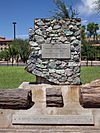 |
| Road | 1943 - 2020 | Jefferson Davis Memorial Highway marker 50 miles east of Phoenix; built by UDC. It was vandalized in August 2017. | ||
| Public | 1984 - 2015 | Picacho Peak State Park | A sign and plaque honored the Battle of Picacho Pass, the westernmost Confederate battle. The sign was removed in 2015 due to damage, and the plaque was moved to a Union monument. |  |
Arkansas
As of June 2020, Arkansas has at least 65 public spaces with Confederate monuments.
State Capitol Monuments
- Confederate Soldiers Monument, also called Defense of the Flag, on the Arkansas State Capitol grounds (1905).
- Confederate War Prisoners Memorial, Arkansas State Capitol grounds.
- Monument to Confederate Women (or "Mother of the South"), Arkansas State Capitol grounds (1913). It shows a mother and daughter saying goodbye to a son leaving for war.
- Old State House, several memorials on its grounds:
- David O. Dodd Memorial (1923)
- Defenders Memorial Plaque (1932)
- Gen. Thomas J. Churchill Memorial (1928)
- Gen. William Read Scurry Memorial (1928)
- Old State House Confederate Memorial
Other Monuments
Many towns have Confederate monuments, often at courthouses or cemeteries. Examples include:
- Arkadelphia: Arkadelphia Confederate Monument (1911)
- Fort Smith: Ft. Smith Confederate Monument (1903)
- Marianna: Gen. Robert E. Lee Monument (1910).
- Star City: Star City Confederate Memorial (1926).
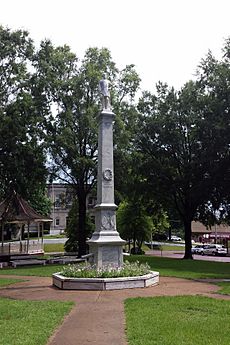
Places Named for Confederates
- Cleburne County (1883), named for CSA Maj. Gen. Patrick Cleburne.
- City of Forrest City (1870), named for CSA Gen. Nathan Bedford Forrest.
- Lee County (1873), named for CSA Gen. Robert E. Lee.
Parks and Roads
- Russellville: Confederate Mothers Memorial Park (1921). This park has three stone monuments honoring Confederate mothers.
- Many roads are named after Confederate figures, such as Robert E. Lee Street in El Dorado and Jefferson Davis Road in Heber Springs.
Schools and State Symbols
- Forrest City: Forrest City High School (1914) and Forrest City Junior High School.
- Little Rock: Robert E. Lee School.
- Flag of Arkansas: The blue star on the flag represents the Confederate States of America. The diamond border is similar to the Confederate battle flag.
California
As of June 2020, California has at least five public spaces with Confederate monuments.
Monuments and Roads
- San Diego: Confederate Soldiers Memorial (1948), at city-owned Mount Hope Cemetery.
- Los Angeles: Johnston Street in Lincoln Heights, named for CSA Gen. Albert Sidney Johnston.
- There are at least four markers for the Jefferson Davis Highway in California.
Schools and Natural Features
- Anaheim: Savanna High School (1961) uses "Johnny Rebel" as its mascot. A statue of a Confederate soldier was removed in 2009.
- Alabama Hills, named for CSS Alabama.
- Jeff Davis Peak and Pickett Peak are mountains named after Confederate figures.
- The Robert E. Lee giant sequoia is in Kings Canyon National Park.
Colorado
Schools and Monuments
- Keenesburg: Weld Central Senior High School and Middle School use "Rebel" as their team name.
- Confederate monument at Riverside Cemetery, Denver (1973).
Mine
- Leadville: Robert E. Lee Mine (1878).
Delaware
As of June 2020, Delaware has at least one public space with Confederate monuments.
- Georgetown: Delaware Confederate Monument, a private monument unveiled in 2007.
District of Columbia
As of June 2020, Washington, D.C. has at least nine public Confederate monuments, mostly in the National Statuary Hall Collection. (See above)
- Albert Pike Memorial (1901): This outdoor statue is owned by the National Park Service. Pike was a Confederate General and a leading Freemason. Protesters tore down the statue in June 2020 due to his Confederate ties.
- A statue of General Robert E. Lee was removed from the U.S. Capitol building in December 2020.
Florida
As of June 2020, Florida has at least 63 public spaces with Confederate monuments.
State Capitol and Symbols
- Confederate monument of Leon County, on the grounds of the former Florida State Capitol (1882).
- Flag of Florida: The current state flag, adopted in 1900, includes the St. Andrew's Cross. Many believe this cross was added to support the Confederacy.
- State Holidays: Robert E. Lee's birthday (January 19), Confederate Memorial Day (April 26), and Jefferson Davis's birthday (June 3) are legal holidays in Florida.
Monuments
Many towns have Confederate monuments, often at courthouses. Examples include:
- Bartow: 7th Florida Infantry Regiment Monument (1982).
- Marianna: Battle of Marianna Monument (1924) and Confederate monument (1881).
- Ocala: Confederate monument (1908), moved to Veterans Memorial Park in 2011.
- Jacksonville: Confederate Park (1907) and Florida's Tribute to the Women of the Confederacy (1915).
- Key West: Confederate memorial fence (1866) and pavilion (1924).
- Olustee: Battlefield monument (1912) and Gen. Joseph Finnegan Monument (1912).
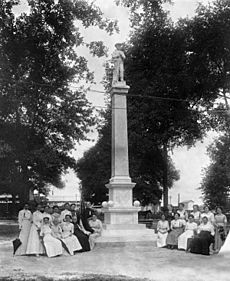
Places Named for Confederates
- Counties like Baker County (1861) and Lee County (1887) are named after Confederate figures.
- Cities like Bartow (1862) and Fort Myers are also named for Confederates.
Parks and Roads
- Ellenton: Judah P. Benjamin Confederate Memorial at Gamble Plantation Historic State Park (1925).
- Jacksonville: Confederate Park and Hemming Park are named after Confederate figures or events.
- Many roads are named after Confederate generals, such as Stonewall Jackson Memorial Highway and Robert E. Lee Road.
Schools and City Symbols
- Gainesville: J.J. Finley Elementary School and Kirby-Smith Center are named after Confederates.
- Jacksonville: Several schools, including J.E.B. Stuart Middle School and Robert E. Lee High School, are named after Confederate generals.
- Panama City: The city flag is similar to the Florida state flag, echoing the Confederate Battle Flag.
Georgia
As of June 2020, Georgia has at least 201 public spaces with Confederate monuments.
Hawaii
- A plaque in the National Memorial Cemetery of the Pacific honors Hawaiians who fought for both the Confederacy and the Union.
Idaho
The settlement of Idaho happened during the Civil War. Settlers from Southern states named several towns and natural features after the Confederacy. As of June 2020, Idaho has at least three public spaces with Confederate monuments.
Places and Features Named for Confederates
- Atlanta: This unincorporated area was named by Southerners after a false report of a Confederate victory.
- Confederate Gulch and Grayback Gulch are former mining communities.
- Leesburg: A former gold mining town named for Robert E. Lee.
- Robert E. Lee Campground and Robert E Lee Creek are in Boise National Forest.
Illinois
The four memorials in Illinois are in Federal cemeteries. They are connected to prisoners of war.
Federal Cemeteries
- Alton: UDC monument (1909), North Alton Confederate Cemetery. It honors Confederate soldiers who died at Alton Military Prison.
- Rock Island: UDC obelisk (2003), Rock Island Confederate Cemetery.
- Springfield: UDC/SCV monument (2005), Camp Butler National Cemetery.
- Chicago: Confederate Mound (1895), Oak Woods Cemetery. This is a mass grave and monument for Confederate soldiers who died at Camp Douglas.
Indiana
As of June 2020, Indiana has at least one public space with Confederate monuments.

- Multiple locations: There are 27 historical markers showing the route of John Hunt Morgan through Indiana.
- Corydon: Corydon Battle Site is a memorial to both sides of the only Civil War battle in Indiana.
- Evansville: The Confederate monument (1904) at Oak Hill Cemetery marks the burial site of 24 Confederate prisoners.
- Indianapolis:
- Confederate Soldiers and Sailors Monument, Garfield Park. The city plans to remove it.
- A granite monument was built in 1933 at Crown Hill National Cemetery for Confederate prisoners.
- Terre Haute: Woodlawn Monument Site (1912), Woodlawn Cemetery.
- Versailles: South Ripley High School named its mascot the Raiders, honoring John Hunt Morgan.
Iowa
As of June 2020, Iowa has at least one public space with Confederate monuments.
- Bentonsport: Monument to Lawrence Sullivan Ross (2007), Iowa's only Confederate general.
- Bloomfield: Confederate Invasion of Iowa Monument (2005).
Kansas
Veterans Memorial Park in Wichita, Kansas, has a Reconciliation Memorial. It is a small monument honoring both North and South combatants.
Kentucky
As of June 2020, Kentucky has at least 37 public spaces with Confederate monuments.
Monuments
- Augusta: Confederate Monument, Payne Cemetery (1903).
- Bardstown: Confederate Monument, Bardstown/St. Joseph's Cemetery (1903).
- Bowling Green: Confederate Monument of Bowling Green, Fairview Cemetery (1876).
- Brandenburg: Confederate monument (2016), moved from Louisville.
- Covington: Veteran's Monument, Linden Grove Cemetery (1933). It honors both Confederate and Union veterans.
- Fairview: Confederate monument at the Jefferson Davis Monument State Historic Site (1924). It has a 35-story obelisk.
- Frankfort: Confederate Monument, Frankfort Cemetery (1892).
- Fulton: Confederate Monument, Fairview Cemetery (1902).
- Georgetown: Confederate Monument, Georgetown Cemetery (1888).
- Harrodsburg: Confederate Monument, Spring Hill Cemetery (1902).
- Lexington: Ladies' Confederate Memorial (1874) and Confederate Soldier Monument in Lexington (1893) at Lexington Cemetery.
- Louisville: Confederate Monument (1895), moved to Brandenburg in 2016.
- Morgantown: Confederate-Union Veterans' Monument, Butler County Courthouse (1907).
- Paducah: Confederate Monument (1907) and General Lloyd Tilghman Statue (1909).
- Perryville: Confederate Monument (1902) at Perryville Battlefield State Historic Site.
- Russellville: Confederate Monument, Town Square (1910).
Places and Roads Named for Confederates
- Lee County (1870).
- Confederate, Kentucky.
- Fairview: Jefferson Davis State Historic Site (1957).
- Many roads are named after Confederate figures, such as Jefferson Davis Highway and Robert E. Lee Drive.
Schools
- Bedford: Trimble County High School's mascot is the Raiders, honoring John Hunt Morgan.
- Eastern: Allen Central High School's teams are nicknamed the "Rebels."
- Richmond: Eastern Kentucky University's teams are nicknamed the "Colonels," a Confederate figure.
Louisiana
As of June 2020, Louisiana has at least 83 public spaces with Confederate monuments.
State Capitol and Buildings
- Gov. Francis T. Nicholls Statue (1934) and Gov. Henry Watkins Allen Statue (1934) at the State Capitol.
- "Silent Sentinel" Monument (1886/1890), moved to the Old Louisiana State Capitol.
- Baton Rouge: Edmund Kirby Smith Hall at Louisiana State University (1965).
- Thibodaux: P.G.T. Beauregard Hall at Nicholls State University (1961). The school is named for Confederate General Francis T. Nicholls.
- New Orleans: Confederate Memorial Hall Museum (1891), the oldest museum in Louisiana.
Monuments
Many towns have Confederate monuments, often at courthouses or cemeteries. Examples include:
- Alexandria: Rapides Parish Confederate Monument (1914).
- Lake Charles: South's Defenders Monument (1915), damaged by Hurricane Laura.
- Shreveport: Confederate Monument (1906), on the grounds of the Caddo Parish courthouse.
- New Orleans: Confederate Monument (1874) at Greenwood Cemetery.
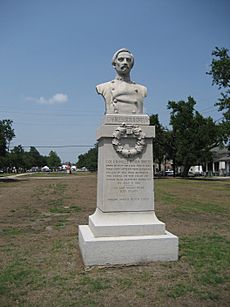
Places and Roads Named for Confederates
- Allen Parish, named after Henry Watkins Allen, Confederate General.
- Beauregard Parish (1913) and Jefferson Davis Parish (1912).
- City of Stonewall (named 1862).
- Many roads are named after Confederate figures, such as Confederate Avenue in Baton Rouge and Robert E. Lee Boulevard in Bossier City.
Schools and Flag Display
- De Ridder: Beauregard Alternative School and East Beauregard High School.
- Louisiana State University is home to the LSU Tigers, named for the Louisiana Tigers, Confederate Civil War regiments.
- Thibodaux: Nicholls State University (1948), named for CSA Brig. Gen. Francis Redding Tillou Nicholls.
- Baton Rouge: The Stars and Bars Confederate flag and the Bonnie Blue Flag are flown behind City Hall.
Maryland
As of June 2020, Maryland has at least three public homages to the Confederacy.
State Symbols
- Flag of Maryland (1904): Features the red-and-white Crossland Banner, used by secessionists during the Civil War.
- The state song "Maryland, My Maryland" calls on the state to join the Confederacy.
Monuments
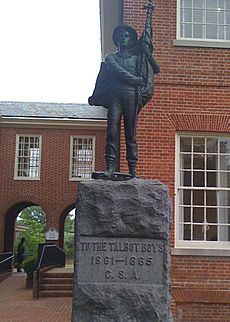
- Baltimore: Confederate monuments at Loudon Park National Cemetery include The Confederate Soldier (1874) and Fort McHenry Monument (1912).
- Easton: "Talbot Boys" Monument (1914) at Talbot County Courthouse.
- Scotland: Confederate Soldiers and Sailors Monument (1876) and Point Lookout Confederate Cemetery Monument (1910).
- Washington County: Robert E. Lee Statue at Antietam Creek (2003).
- Frederick: Monument to the Unknown Confederate Soldiers (1881) at Mount Olivet Cemetery.
- Silver Spring: Confederate Monument (1896) at Grace Episcopal Church Cemetery.
- White's Ferry: A Confederate monument was moved here from Rockville in 2017. The statue was removed in June 2020, but the pedestal remains.
Places and Roads Named for Confederates
- Confederate Hills: A community near Antietam National Battlefield with streets named after Confederate generals.
- Potomac: Jubal Early Court and J. E. B. Stuart Road.
Ferry
- Montgomery County: A ferry, formerly named Gen. Jubal A. Early, was renamed Historic White’s Ferry in June 2020.
Gallery
-
Confederate Memorial in Silver Spring to 17 unknown soldiers buried at Grace Episcopal Church Cemetery after the Battle of Fort Stevens
Massachusetts
As of May 2019, all public memorials listed by the Southern Poverty Law Center had been removed.
Private Memorials
- Cambridge: Memorial Hall at Harvard University has stained-glass windows honoring various figures, including those from the Civil War.
Michigan
As of June 2020, Michigan has at least one public monument of a Confederate soldier.
- Allendale: Part of the Veterans Garden of Honor (1998), a statue shows a Union soldier and a Confederate soldier with a young slave at their feet.
Mississippi
As of June 2020, Mississippi has at least 147 public spaces with Confederate monuments.
Missouri
As of June 2020, Missouri has at least 19 public spaces with Confederate monuments.
Monuments
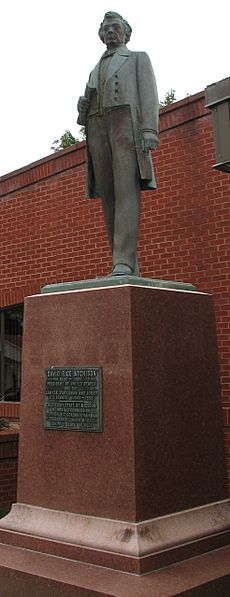
Many towns have Confederate monuments, often at courthouses. Examples include:
- Cape Girardeau: Confederate War Memorial (1931).
- Columbia: Confederate Monument (1935), moved to the Centralia Battlefield in 2015.
- Plattsburg: Statue of CSA Brig Gen David Rice Atchison.
- Higginsville: Confederate Memorial State Historic Site (1906).
- Kansas City: UDC monument at Forest Hill and Calvary Cemetery.
- Springfield: Two monuments at Springfield National Cemetery.
- St. Louis: Memorial to the Confederate Dead (1988).
Places and Roads Named for Confederates
- Atchison County, Missouri, named for Brig Gen David Rice Atchison.
- Breckenridge, named for John C. Breckinridge.
- Keytesville: Price Park memorializes Maj. Gen. Sterling Price.
- Roads like South Robert E. Lee Street in Battlefield and Jefferson Davis Drive in Hillsboro.
Schools
- Southland C-9 School District: Uses the Rebelman mascot and red, gray, and white school colors.
Montana
As of June 2020, Montana has at least two public spaces with Confederate monuments.
- Beaverhead: Confederate Dam and Jeff Davis Creek.
- Confederate Gulch: A historic gold mining camp founded by Confederate soldiers.
Nevada
As of June 2020, Nevada has at least one public space with Confederate monuments.
- Jeff Davis Peak in White Pine County was named in 1855 after Jefferson Davis.
New Jersey
There is at least one public space dedicated to the Confederacy in New Jersey.
- Pennsville Township: Confederate Monument (1910), Finn's Point National Cemetery. It honors 2,436 Confederate prisoners who died at Fort Delaware.
New Mexico
As of June 2020, New Mexico has at least one public space with Confederate monuments.
- Santa Fe: Confederate memorial (1993) at Santa Fe National Cemetery.
- Socorro: Confederate monument (2012) called Victory Awaits You.
New York
As of June 2020, New York has at least three public spaces with Confederate monuments.
Monuments
- Central Park: A statue of J. Marion Sims, a controversial surgeon and Confederate spy, was removed in April 2018.
- Brooklyn: A plaque for Robert E. Lee at St. John's Episcopal Church was removed in 2017.
- Elmira: UDC monument (1937) at Woodlawn National Cemetery, for Confederate soldiers who died in Elmira Prison.
- The Bronx: Busts of Stonewall Jackson and Robert E. Lee at the Hall of Fame for Great Americans were removed.
Roads
- Fort Hamilton, Brooklyn: General Lee Avenue and Stonewall Jackson Drive. Governor Andrew Cuomo has asked for these streets to be renamed.
- Throggs Neck, The Bronx: Longstreet Avenue, named for CSA Gen. James Longstreet.
North Carolina
As of June 2020, North Carolina has at least 164 public spaces with Confederate monuments.
Ohio
As of June 2020, Ohio has at least five public spaces with Confederate monuments.
Historical Markers and Monuments
- In 2013, Ohio put up 32 historical markers for the John Hunt Morgan Heritage Trail.
- Columbus: Camp Chase Cemetery's Confederate Soldier Memorial (1902). The statue was vandalized in 2017 but repaired and reinstalled in 2019.

- Pomeroy: Statue of Confederate general John Hunt Morgan.
- Sandusky Bay: Four UDC monuments at Confederate Stockade Cemetery on Johnson's Island.
- West Point: Marker for Battle of Salineville, the northernmost point Confederate forces reached.
Places and Roads Named for Confederates
- Confederate Hills: A neighborhood in Batavia Township with roads named for CSA leaders and Southern locations.
- Roads like Stonewall Ridge in Batavia Township and Robert E Lee Drive in Fairfield.
Schools
- Cleveland: John Adams High School uses the Rebels team name.
- Mcconnelsville: Morgan High School is named for Confederate General John Hunt Morgan. Their nickname is the "Raiders."
- Willoughby: Willoughby South High School removed Confederate imagery but kept the Rebels team name.
Oklahoma
As of June 2020, Oklahoma has at least 13 public spaces with Confederate monuments.
Buildings and Monuments
- Ardmore: Oklahoma Confederate Home, now Oklahoma Veterans Center.
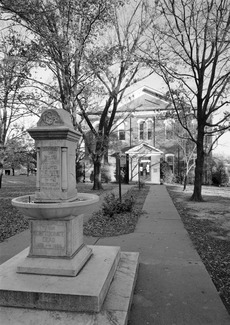
- Ardmore: Confederate Monument (1910) and (2013).
- Delaware County: Two monuments to CSA General Stand Watie.
- Durant: Confederate Soldier Statue (1917) at Bryan County Courthouse.
- Tahlequah: Confederate Monument (1913) at Cherokee National Capitol, removed in 2020.
Schools and Places Named for Confederates
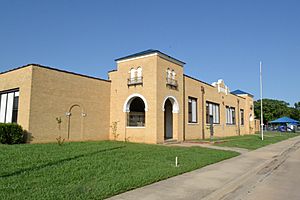
- Durant: Robert E. Lee Elementary School.
- Oklahoma City: Robert E. Lee Elementary School and Stonewall Jackson Elementary School.
- Jackson County (1907), possibly named for a CSA General.
- Town of Stonewall (1874) for Stonewall Jackson.
Oregon
As of June 2020, Oregon has no public spaces with Confederate monuments.
Pennsylvania
As of June 2020, Pennsylvania has at least three public spaces with Confederate monuments.
Monuments
- Gettysburg: Gettysburg Battlefield has many monuments to Confederate soldiers and units. Examples include:
- Alabama State Monument (1933).
- Army of Northern Virginia Marker (1908).
- Gen. Robert E. Lee Equestrian Statue (1917), atop the Virginia State Monument.
- North Carolina State Monument (1929).
- Virginia State Monument (1917).
- McConnellsburg: Confederate Soldiers Monument (1929) and Last Confederate Bivouac Monument (1930).
- Philadelphia: Confederate Soldiers and Sailors Monument (1911) at Philadelphia National Cemetery.
Roads
- Gettysburg: Confederate Avenue.
- McConnellsburg: Confederate Lane.
Rhode Island
As of June 2020, Rhode Island has no public spaces with Confederate monuments.
South Carolina
As of June 2020, South Carolina has at least 194 public spaces with Confederate monuments.
South Dakota
As of June 2020, South Dakota has at least one public space with Confederate monuments.
- Gettysburg: The Gettysburg police uniforms feature a patch with overlapping U.S. and Confederate flags.
Tennessee
As of June 2020, Tennessee has at least 105 public spaces with Confederate monuments. The Tennessee Heritage Protection Act (2016) limits the removal of statues.
The Tennessee legislature made June 3 Confederate Decoration Day, and January 19 (Robert E. Lee Day) and July 13 (Nathan Bedford Forrest Day) are also designated days.
State Capitol and Buildings
- Nathan Bedford Forrest Bust: On display in the Capital rotunda since 1978. Efforts to remove it have not been successful.
- Murfreesboro: Forrest Hall at Middle Tennessee State University.
Monuments


Many towns have Confederate monuments, often at courthouses. Examples include:
- Bolivar: Monument to the Memory of Fallen Confederate Sons (1873).
- Covington: Confederate Monument (1895).
- Dover: Fort Donelson has a Confederate Monument (1933).
- Franklin: "Our Confederate Soldiers" Monument (1899), known as "Chip."
- Nashville: Tennessee Confederate Women's Monument (1926).
- Pulaski: "Rebel Martyr" Sam Davis Statue (1906).
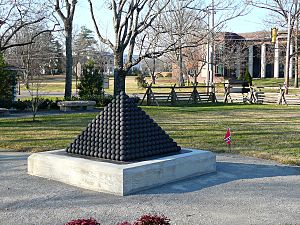
- Franklin: Cannonballs are stacked in a pyramid to remember where CSA General Patrick Cleburne died.
- Memphis: Confederate Memorial (1878) at Elmwood Cemetery.
- Nashville: Confederate Private Monument (1909) in Centennial Park.
- Nashville: Nathan Bedford Forrest Statue, a large fiberglass statue on private land near Interstate 65, installed in 1998.
Places and Roads Named for Confederates
- Dixie Lee Junction, an unincorporated community where the Dixie and Lee Highways meet.
- Eva: Nathan Bedford Forrest State Park (1963).
- Many roads are named after Confederate figures, such as Jefferson Davis Drive in Brentwood and Robert E. Lee Drive in Nashville.
Schools and Tourist Sites
- Chapel Hill: Forrest High School.
- Nashville: Father Ryan High School, named for Abram Ryan, called "Poet of the Confederacy."
- Sewanee: The University of the South: This university has many ties to the Confederacy, including stained glass windows with Confederate flags (now removed) and portraits of Confederate figures.
- Pigeon Forge: "Rebel Railroad" was a theme park built in 1961, featuring a simulated Confederate steam train. It is now Dollywood.
Texas
As of June 2020, Texas has at least 205 public spaces with Confederate monuments.
State Capitol and Symbols
- The Texas State Capitol itself is considered a Confederate monument.
- Confederate Soldiers Monument (1903) features statues of Confederate soldiers and Jefferson Davis.
- Hood's Texas Brigade Monument (1907) and Terry's Texas Rangers Monument (1907) honor those who fought for the Confederacy.
- Seal of Texas: The reverse side includes the flag of the Confederate States of America.
- State Holiday: Confederate Heroes Day is celebrated on January 19. April is Confederate History Month.
Monuments
Many monuments were donated by pro-Confederacy groups like the Daughters of the Confederacy.

- Corsicana: Call to Arms (Confederate Soldiers' Monument) (1907).
- Denton: Denton Confederate Soldier Monument (1918), removed in June 2020.
- Galveston: Dignified Resignation (1909), honoring Confederate soldiers and sailors.
- Georgetown: Confederate Soldiers and Sailors Monument (1916).
- Granbury: Statue of CSA General Hiram B. Granbury (1913).

- Anderson: Confederate Memorial Plaza (2010) flies a Confederate flag.
- Austin: Littlefield Fountain at University of Texas commemorates George W. Littlefield, a CSA officer.
- Houston: Spirit of the Confederacy (1908) and Statue of Richard W. Dowling (1905).
- Palestine: John H. Reagan Memorial (1911).
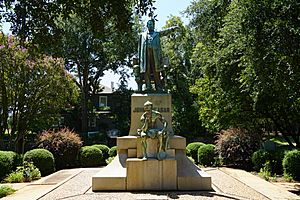
- Orange: The Confederate Memorial of the Wind is under construction and will be the largest Confederate monument built since 1916.
Places and Roads Named for Confederates
- Many counties are named after Confederate figures, such as Hood County (1866) for John Bell Hood and Jeff Davis County (1887) for Jefferson Davis.
- Cities like Cleburne (1871) and Robert Lee are also named for Confederates.
- Confederate Reunion Grounds State Historic Site, Limestone County.
- Many roads are named after Confederate figures, such as Robert E. Lee Road in El Paso and Jefferson Davis Drive in Houston.
Schools
- Abilene: Jackson Elementary School and Lee Elementary School.
- Austin: John H. Reagan Early College High School (1965) and William B. Travis High School (uses "Rebels").
- Dallas: Stonewall Jackson Elementary School (1939).
- Houston: Davis High School (1926) and Dowling Middle School (1968) were renamed in 2016.
- Midland: Lee High School (1961) uses "Rebels" as its team name.
- San Antonio: Robert E. Lee High School (1958) was renamed Legacy of Educational Excellence, or LEE High School.
Utah
- Dixie: A region of Washington County, Utah, settled by Southerners.
- Dixie State University, St. George, Utah.
Vermont
Virginia
As of June 2020, Virginia had at least 241 public spaces with Confederate monuments, more than any other state. Virginia also has many schools, highways, and roads named for Confederates. Some have been removed since. Lee-Jackson Day is no longer a state holiday.
Washington State
As of June 2020, only one public space has a Confederate-connected monument in Washington.
- Bellingham: Pickett House, listed on the National Register of Historic Places.
At least two private properties have Confederate memorials or flags:
- Clark County: Jefferson Davis Park (2007) displays Confederate flags.
- Seattle: United Confederate Veterans Memorial (1926) at Lake View Cemetery. It was toppled by unknown persons in July 2020.
West Virginia
As of 2020, there were 21 public spaces with Confederate monuments in West Virginia.
State Capitol and Monuments
- Bust of Stonewall Jackson (1959) and a statue of Stonewall Jackson (1910) are at the West Virginia State Capitol.
- Bunker Hill, West Virginia: Monument marking the death of Brig.-Gen. James Johnston Pettigrew.
- Clarksburg: Bronze equestrian statue of Stonewall Jackson (1953).
- Harpers Ferry: Heyward Shepherd Monument (1931). This monument was put up by UDC and SCV and was seen as a "Faithful Slave Memorial."
- Romney: First Confederate Memorial (1867).
Places, Parks, and Roads Named for Confederates
- Bartow, named for Confederate Colonel Francis S. Bartow.
- Weston: Stonewall Jackson Lake State Park (1990).
- Many roads are named after Confederate figures, such as Beauregard Boulevard in Charles Town and Stonewall Jackson Highway in Flatwoods.
Schools
- Charleston: Stonewall Jackson Middle School.
Wisconsin
- Prairie du Chien: United Daughters of the Confederacy (UDC) monument to Jefferson Davis at Fort Crawford Cemetery.
- Wisconsin Dells: The Confederate spy Belle Boyd is buried in Spring Grove Cemetery. Her grave is marked with a Confederate flag.
Wyoming
Natural Features
- Yellowstone National Park: The Lamar River (named 1884–85) is named for L.Q.C. Lamar, a secessionist and Confederate ambassador.
International Confederate Symbols
Brazil
- After the American Civil War, some Southerners moved to Brazil, which still allowed slavery. These emigrants were called Confederados. A Confederate monument was built in Americana, Brazil.
Canada
- Kincardine, Ontario: A monument honors Solomon Secord, a Confederate army physician.
- Kitchener, Ontario: Eastwood Collegiate Institute (1956) replaced its "Johnny Rebel" mascot and Confederate imagery in 1999, but kept the "Rebel" name.
- Montreal, Quebec: A plaque honoring Jefferson Davis was removed in 2017.
Ireland
- Tuam: Ireland honored CSA Major Richard W. Dowling with a bronze memorial plaque on the Town Hall.
Scotland
- Edinburgh: Dean Cemetery has an obelisk for Scottish-born CSA Colonel Robert A. Smith, with a Confederate marker and flags.
Images for kids


